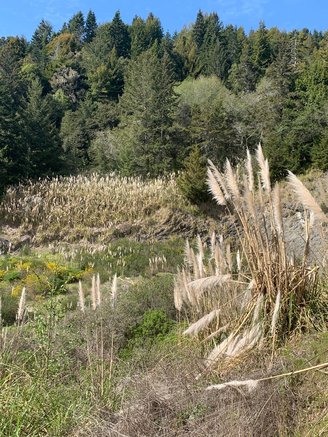For some, they’re “old dishrags on sticks,” an ever-growing threat to native plants, the poster child for invasive species. For others, they’re a boon, healing the scars wrought by fires and clear-cut logging, softening the blemishes left by quarrymen, soothing the blight of naked road cuts. Usually and generically referred to as “pampas grass,” Cortaderia selloana, what we usually see around Humboldt is actually a different species, Cortaderia jubata, aka “jubata grass” or “Andean pampas grass.” Or “that damn weed.” Save your wrath or pleasure for jubata, not pampas grass.
True pampas grass really does come from the pampas of South America, in particular from Brazil, Chile and Argentina. It seems to have arrived in California in 1848, through the efforts of the former head gardener of the Edinburgh Royal Botanical Garden. In 1828, at age 53, James Tweedie quit his job and country and emigrated to Argentina, where he collected native plants and sent seeds all over. According to an old article in Pacific Horticulture, “The [pampas grass] plumes were in great demand throughout Europe, and in this country in the 1880s there was hardly a parade without pampas grass plumes to decorate the floats.”

A veritable forest of jubata grass softens the scars of a quarry on the Big River Trail south of Mendocino. The quarry was last worked in 2002. (Barry Evans)
Jubata grass — the weed! — is made of hardier mountain stuff, coming from the Andes of Ecuador, Peru and Chile. It seems to have arrived here more recently, via a nursery in Nancy, France. According to the same article, it wasn’t even mentioned in Sunset’s Western Garden Book until 1976. While the comparatively tame pampas grass works best in gardens as an ornamental, confining its seeds to the local environment, jubata plumes (harking back to my riff on sperm counts two weeks ago) “spill theirs just anywhere.” Because of its sharp leaves, it was once planted by foresters as a barrier to deter deer from eating young shoots after logging. (“Cortaderia” comes from Spanish “cortar,” to cut.) Again quoting from Pacific Horticulture, “Later, however, the grass itself crowded out the young seedlings. In the 1960s Georgia Pacific had to abandon 1,100 acres in California’s Humboldt County to jubata grass as there was no economical way to control it.” Can any reader offer details?
The reason jubata is so prolific — and therefore hated — compared to its pampas cousin is, wouldn’t you know, sex. Pampas comes in female and male versions, needing both to participate for fertilization to occur. Well yeah, you say. However, all-female jubata has a nifty trick up its sleeve: it reproduces by apomixis, that is, it fertilizes itself. (Back to two weeks ago — is this the answer to falling sperm counts?) Once mature — which apparently takes no time at all — the plants shed their seeds, thousands at a time. No declining population problems with these guys, that is, gals.
Being botanically-challenged and as one who hasn’t had to deal with the threat of invasive species, I really have no idea just how dangerous is the spread of jubata grass. I trust you’ll enlighten me in the comments.
CLICK TO MANAGE